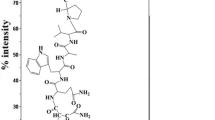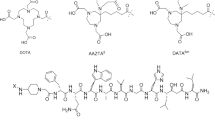Abstract
Bombesin (BNN)-like peptides have very high binding affinity for the gastrin-releasing peptide (GRP) receptor. The goal of the current study was to optimize the labeling conditions of a new 99mTc-radiolabeled BNN-like peptide based on the bifunctional chelating ligand HYNIC using different co-ligands (EDDA and tricine). The radiolabeling conditions (pH, amount of co-ligand, amount of stannous chloride, temperature and reaction time) for newly-formed 99mTc-tricine-HYNIC-Q-Litorin and 99mTc-EDDA-HYNIC-Q-Litorin were optimized and evaluated by RHPLC and RTLC. Radiochemical yields for 99mTc-tricine-HYNIC-Q-Litorin and 99mTc-EDDA-HYNIC-Q-Litorin were 98.0 ± 1.7 and 97.5 ± 2.5%, respectively. When EDDA was used as co-ligand, the labeling of 99mTc-EDDA-HYNIC-Q-Litorin was optimal in the following reaction mixture: HYNIC-peptide: EDDA: 10 μg/5 mg, pH 3, SnCl2 concentration: 12 μg/0.1 mL, reaction temperature: 100 °C, reaction time: 15 min. Besides, the optimum conditions were HYNIC-peptide:tricine: 10 μg/50 mg, pH 5, SnCl2 concentration: 12 μg/0.1 mL, reaction temperature: 100 °C, reaction time: 15 min for preparing 99mTc-tricine-HYNIC-Q-Litorin. The manufactured 99mTc-HYNIC-Q-Litorin conjugates may offer new possibilities for imaging cancer cells expressing bombesin receptors.









Similar content being viewed by others
References
Faintuch BL, Santos RLSR, Souza ALFM, Hoffman TJ, Greeley M, Smith CJ (2005) 99mTc-HYNIC-Bombesin (7–14)NH2: radiochemical evaluation with co-ligands EDDA (EDDA = Ethylenediamine-N,N′-diacetic acid), Tricine, and Nicotinic acid. Synth React Inorg Met-Org Nano-Met Chem 35:43–51
Shi J, Jia B, Liu Z, Yang Z, Chen K, Chen X, Liu S, Wang F (2008) 99mTc-labeled bombesin (7–14)NH2 with favorable properties for SPECT imaging of colon cancer. Bioconj Chem 19:1170–1178
Miranda-Olvera AD, Ferro Flores G, Pedraza-Lopez M, Arteaga de Murphy C, De Leon Rodriguez LM (2007) Synthesis of oxytocin HYNIC derivatives as potential diagnostic agents for breast cancer. Bioconj Chem 18:1560–1567
Babich JW, Coco WG, Barrow S, Fischman AJ, Femia FJ, Zubieta J (2000) 99mTc-labeled chemotavtic peptides: influence of coligand on distribution of molecular species and infection imaging properties. Synthesis and structural characterization of model complexes with the Re(η2-HNNC5H4 N)(η1-NNC5H4N) core. Inorg Chim Acta 309:123–126
Banerjee SR, Maresca KP, Stephenson KA, Valliant JF, Babich JW, Graham WA, Barzana M, Dong Q, Fischman AJ, Zubieta J (2005) N,N-Bis(2-mercaptoethyl) methylamine: a new coligand for Tc-99m labeling of hydrazinonicotinamide peptides. Bioconj Chem 16:885–902
Decristoforo C (1999) Mather S.J: 99mTc-Technetium-labeled peptide-HYNIC conjugates: effects of lipophilicity and stability on biodistribution. Nucl Med Biol 26:389–396
Gandomkar M, Najafi R, Shafiei M, Mazidi M, Ebrahimi SES (2007) Precilinical evaluation of [99mTc/EDDA/Tricine/HYNIC0, 1-NaI3, Thr8]-octreotide as a new analogue in the detection of somatostatin-receptor-positive tumors. Nucl Med Biol 34:651–657
Decristoforo C, Mather S (1999) Technetium-99m somatostatin analogues: effect of labeling methods and peptide sequence. Eur J Nucl Med 26:869–876
Santos-Cuevas CL, Ferro-Flores G, Murphy CA, Pichardo-Romero PA (2008) Targeted imaging of gastrin-releasing peptide receptors with 99mTc-EDDA/HYNIC-[Lys3]-Bombesin: biokinetics and dosimetry in women. Nucl Med Commun 29(8):741–747
La Bella R, Garcia-Garayoa E, Bahler M, Blauenstein P, Schibli R, Conrath P, Tourwe D, Schubiger PA (2002) A 99mTc(I)-postlabeled high affinity bombesin analogue as a potential tumor imaging agent. Bioconj Chem 13:599–604
Durkan K, Yurt Lambrecht F, Unak P (2007) Investigation of radiopharmaceutical potential and labeling methods of bombesin like peptide: litorin with Tc-99m. Bioconj Chem 18:1516–1520
Melendez-Alafort L, Maria Ramirez F, Ferro-Flores G, Murphy GA, Pedreza-Lopez M, Hnatowich DJ (2003) Lys and Arg in UBI: a specific site for a stable Tc-99m complex. Nucl Med Biol 30:605–615
Ono M, Arano Y, Uehara T, Fujioka Y, Ogawa K, Namba S, Mukai T, Nakayama M, Saji H (1999) Intracellular metabolic fate of radioactivity after injection of technetium-99m-labeled hydrazino nicotinamide derivatized proteins. Bioconj Chem 10:386–394
Ferro-Flores G, Arteaga de Murphy C, Rodriguez-Cortes J, Pedraza-Lopez M, Ramirez-Iglesias MT (2006) Preparation and evaluation of 99mTc-EDDA/HYNIC-[Lys3]-bombesin for imaging gastrin-releasing peptide receptor-positive tumours. Nucl Med Commun 27:371–376
Purohit A, Liu S, Casebier D, Edwards DS (2003) Phosphine-containing HYNIC derivatives as potential bifunctional chelators for 99mTc-labeling of small biomolecules. Bioconj Chem 14:720–727
Decristoforo C, Mather SJ (1999) Preparation, 99mTc-labeling, and in vitro characterization of HYNIC and N3S modified RC-160 and [Tyr3]octreotide. Bioconj Chem 10:431–438
Gandomkar M, Najafi R, Shafiei M, Ebrahimi SES (2007) Confirmation of hydrazone formation in HYNIC-peptide conjugate preparation, and its hydrolysis during labeling with 99mTc. Appl Rad Isot 65:805–808
King RC, Bashir-Uddin Surfraz M, Biagini SCG, Blower PJ, Mather SJ (2007) How do HYNIC-conjugated peptides bind technetium? Insights from LC-MS and stability studies. Dalton Trans 43:4998–5007
Uddin-Surfraz MB, King R, Mather SJ, Biagini S, Blower PJ (2009) Technetium-binding in labeled HYNIC-peptide conjugates: role of coordinating amino acids. J Inorg Biochem 103:971–977
Rennen HJJM, Boerman OC, Koenders EB, Oyen WJG, Cornstens FHM (2000) Labeling proteins with Tc-99m via hydrazinonicotinamide (HYNIC): optimization of the conjugation reaction. Nucl Med Biol 27:599–604
Liu G, Wescott C, Sato A, Wang Y, Liu N, Zhang YM, Rusckowski M, Hnatowich DJ (2002) Nitriles form mixed-coligand complexes with 99mTc-HYNIC-peptide. Nucl Med Biol 29:107–113
Decristoforo C, Mather SJ (2002) The influence of chelator on the pharmacokinetics of 99mTc-labeled peptides. Q J Nucl Med 46:195–205
Sadehzadeh N, Gandomkar M, Najafi R, Shafiei M, SadatEbrahimi SE, Shafiee A, Larijani B (2010) Preparetion and evaluation of a new 99mTc labeled bombesim derivative for tumor imaging. J Radioanal Nucl Chem 283:181–187
Acknowledgements
The authors gratefully acknowledge the financial support received from the Scientific and Technological Research Council of Turkey, Scientific Project (TUBITAK Number 108S200).
Author information
Authors and Affiliations
Corresponding author
Rights and permissions
About this article
Cite this article
Yurt Lambrecht, F., Durkan, K. & Bayrak, E. Labeling bombesin-like peptide with 99mTc via hydrazinonicotinamide: description of optimized radiolabeling conditions. J Radioanal Nucl Chem 284, 539–545 (2010). https://doi.org/10.1007/s10967-010-0530-8
Received:
Published:
Issue Date:
DOI: https://doi.org/10.1007/s10967-010-0530-8




